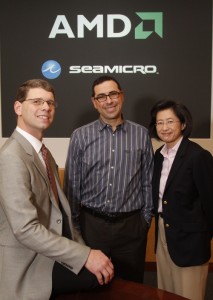 Intel suffered a setback in the server market with the news that its former partner, SeaMicro, is being acquired by AMD. But the world’s top chip maker said it was internally developing technology to remain competitive in the dense server market.
Intel suffered a setback in the server market with the news that its former partner, SeaMicro, is being acquired by AMD. But the world’s top chip maker said it was internally developing technology to remain competitive in the dense server market.
Intel is developing integrated fabrics to boost I/O and high-performance networking and storage in servers, said Jason Waxman, general manager of Intel’s data centre business unit, in an interview. The technologies are being developed as the company tries to boost its presence in the market for dense servers used in cloud computing deployments in data centres.
AMD is paying US$334 million for SeaMicro, which until now was in a tight partnership with Intel to develop dense servers. AMD plans to sell SeaMicro-branded servers and license to customers its fabric technology, which virtualises I/O and ties together storage and networking. The deal is expected to close in March.
SeaMicro provides AMD an instant presence in the nascent but fast-growing dense server market, and Intel will now be playing catch-up, analysts said. SeaMicro currently sells servers only with Intel processors, and it is likely that AMD will swap those with its own chips. Intel said it will continue to provide processors for SeaMicro servers, depending on the requirements.
AMD’s purchase of SeaMicro was an unexpected but smart move, said Nathan Brookwood, principal analyst at Insight 64. The dense server market is growing as companies look to curb electricity costs by deploying low-power servers to respond to Web and database queries.
But AMD’s prize in the acquisition is SeaMicro’s specialised fabric, Brookwood said. SeaMicro’s dense servers have many credit-card-sized motherboards that are connected by the fabric, which reduces the need for extra storage and network controllers.
It could take Intel years to develop technology that is competitive with SeaMicro’s fabric, Brookwood said. And Intel will need to prove its technology is reliable before it is widely adopted.
“Intel has all the pieces and all the technology and the smart people to put this together. But it takes time,” Brookwood said.
The SeaMicro deal gives AMD a technological head start, but it will also intensify Intel’s focus on developing related technology, said Dean McCarron, principal analyst at Mercury Research.
Intel’s Waxman didn’t specify how Intel would build the fabric and I/O technology, but said the company would utilise assets from recently acquired networking companies. In July it acquired Fulcrum Microsystems, which makes Ethernet switches, and last month it purchased InfiniBand assets from Qlogic, which provides high-performance fabric technology for servers. Intel also will remain competitive through new processors, memory and system management technologies.
But by the time Intel’s fabric technology matures, analysts said that AMD could be far ahead in the integration of SeaMicro’s technology inside chips. AMD in the future will allow implementation of third-party intellectual property inside chips, and by 2013 or 2014, SeaMicro’s IP could be inside Opteron server chips.
Currently SeaMicro’s ASIC (application-specific integrated circuit) controlling the fabric is placed on the motherboard alongside the processor and memory. When integrated inside a chip, it could be similar to Calxeda’s EnergyCore chip, which will be used by Hewlett-Packard in its upcoming ARM server. The Calxeda chip includes cache, an 80-Gigabit fabric switch and a management engine for power optimisation.
AMD will be able to license the fabric technology to work on ARM processors, which could also put pressure on Intel, analysts said. ARM processors are mainly found in smartphones and tablets, but there is growing interest in building power-efficient ARM servers.
AMD will be able to differentiate its offerings from Intel’s by offering SeaMicro technology with either ARM or x86 processors as early as 2013, said Matt Eastwood, group vice president for enterprise platform research at IDC.
AMD currently offers only x86 chips, but the company’s chief technology officer, Mark Papermaster, has not ruled out implementing ARM IP on its future chips.
But Intel’s Waxman said the AMD-SeaMicro deal does not change Intel’s dense server strategy, and the chip maker will continue to work with customers like Dell and Tyan.
“A part of our strategy is to provide a full portfolio of ingredients. We’ve got the right assets in our arsenal,” Waxman said.





